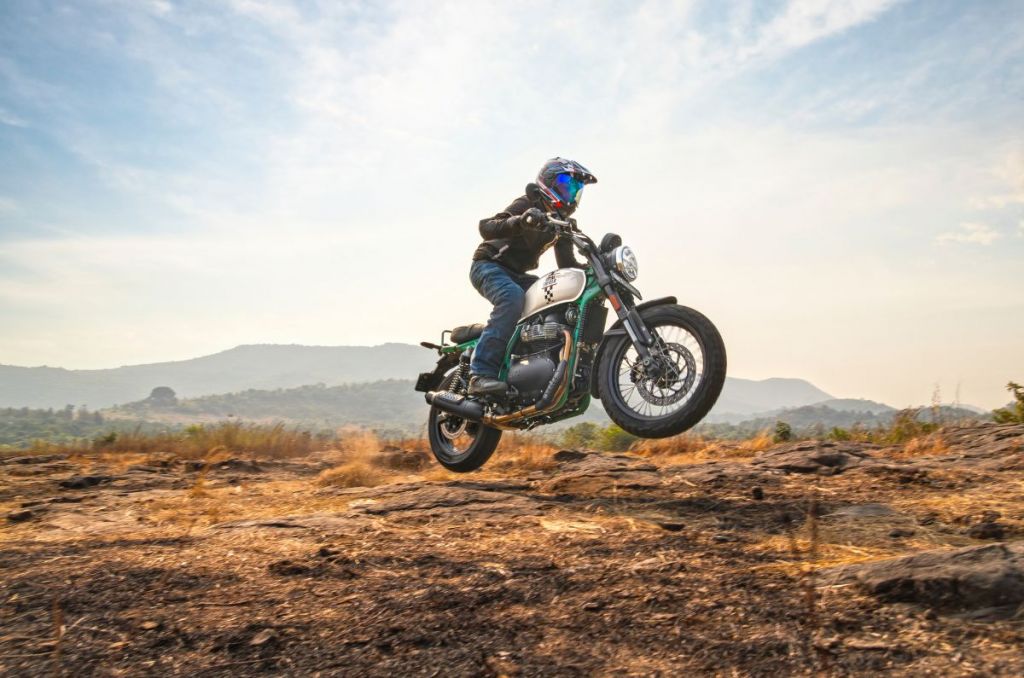
Longer travel suspension, lower weight and more features - these three things were evident on spied test bikes ages ago and they all promised that the new Bear 650 had the potential to be RE’s finest twin yet. Now that we’ve finally ridden the bike in India, we can confirm if that’s how things have panned out.
Royal Enfield Bear 650: Weight and dimensions
While it actually weighs just 2 kilos less than the Interceptor (216kg vs 218kg) the Bear feels more manageable as soon as you ride it out of the showroom. That’s thanks to the single exhaust pipe that hugs the motorcycle more closely than the wide dual pipes on the rest of the 650s which need more careful management in heavy traffic. Beyond that, the Bear also manages to feel a little more agile and lighter on its feet.

Chassis wise, it's based on the Interceptor platform, but with a strengthened headstock and a new rear subframe. Wheel sizes have gone from 18-inch at both ends to a 19/17 set-up and there’s now more suspension travel as well - climbing from 110mm/88mm to 130mm/115mm at the front and rear respectively.
Royal Enfield Bear 650: Ergonomics
The riding position is not what I’d have expected given that this is meant to be a scrambler. The footpeg placement is quite nice - a little lower and more forward set than the Interceptor.

However the new wide handlebar still positions in a slight forward lean. It's not uncomfortable by any means, but definitely more roadster than scrambler.
Royal Enfield Bear 650: Performance
With the move to a two-into-one exhaust, RE was able to liberate a bit more torque, but the actual performance gains are higher than the spec sheet would suggest. The parallel engine is now more responsive, acceleration feels stronger and the accompanying soundtrack is both louder and more exciting.

Our test results show a significant improvement over the Interceptor/Conti GT as well with this being the first RE to dip below the 6s mark in our 0-100 tests.
Royal Enfield Bear 650: Ride and handling
Handling seems more sure-footed and grown up feeling as well. High speed stability is much better with none of the mild steering weave you’ll encounter on the INT. Thankfully, the brakes are better too, with a sharper bite that demands less lever effort. However the ABS can get triggered quite easily and you will be very aware of the bike’s weight under heavy braking.

It’s a similar story in the corners - as long as you’re mindful of the Bear’s size and weight, you can have quite a lot of fun. There’s good cornering clearance and the bike holds a line nicely once you get it pointed in the right direction. The new MRF Nylorex tyres do well on smooth grippy tarmac, but they feel a bit vague and greasy on less than perfect surfaces.

This is where the Bear 650 finds its main shortcoming. The suspension - particularly at the rear is too firm for this bike’s own good. It’s not to the point of being an absolute deal breaker, but you feel every imperfection in the road and if you were looking forward to a plush and comfy bike this is not it.

That being said, it's still fun if you throw some light off roading at the bike with decent ground clearance and plenty of torque to spin up the rear. You can also deactivate the rear ABS, but the overall weight and the front fork’s tendency to bottom out on big landings mean you shouldn’t take it too seriously.
Royal Enfield Bear 650: Verdict
The Bear 650 is equipped with the TFT display from the Himalayan 450, although you don’t have the choice of spoked wheels that support tubeless tyres here. Priced between Rs 3.39-3.59 lakh ex-showroom depending on which of the five colours you pick, I think the value proposition is fair.

It is about 40k more than the Interceptor, but also more capable and better equipped. Most of all, I believe that this is the best 650 yet, but that suspension set up restricts the Bear to the point of being a good motorcycle - which is a pity, because it had the potential to be a great one.